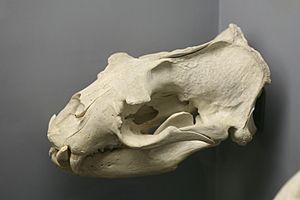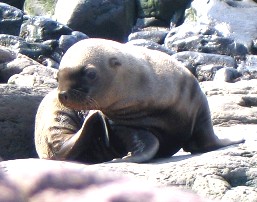Steller sea lion facts for kids
Quick facts for kids Steller sea lion |
|
|---|---|
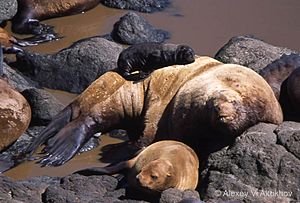 |
|
| Adult male, female and pup on Yamsky Islands in the northeast Sea of Okhotsk | |
| Conservation status | |
| Scientific classification | |
| Genus: |
Eumetopias
|
| Species: |
jubatus
|
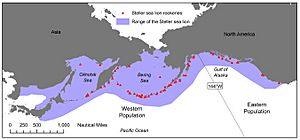 |
|
| Range of Steller sea lions (purple = overall range, red = breeding rookeries) | |
The Steller sea lion (Eumetopias jubatus) is also called the Steller's sea lion or northern sea lion. It is a large sea lion found in the northern Pacific Ocean. This animal is considered a near-threatened species, meaning its numbers are decreasing.
It is the only member of its group, Eumetopias, and the biggest of all eared seals. Among all pinnipeds (fin-footed mammals like seals and walruses), only the walrus and elephant seals are larger. The Steller sea lion is named after Georg Wilhelm Steller, a naturalist who first described them in 1741. Scientists have been very interested in these sea lions because their numbers have dropped a lot in parts of Alaska.
Contents
About Steller Sea Lions
Adult Steller sea lions are lighter in color than most other sea lions. Their fur can be pale yellow, tan, or sometimes reddish. Baby Steller sea lions, called pups, are born almost black. They weigh about 23 kg (50 lb) and stay dark for several months.
Both male and female sea lions grow quickly until they are about five years old. After that, females grow much slower. Adult females are usually about 2.3 to 2.9 meters (7.5 to 9.5 ft) long. They weigh between 240 and 350 kg (530 and 770 lb).
Males keep growing until they are five to eight years old. They are a bit longer than females, reaching about 2.82 to 3.25 meters (9.25 to 10.7 ft) long. Males are much heavier, weighing from 450 to 1120 kg (990 to 2470 lb). Males also have wider chests, necks, and heads. They have a thick mane of coarse hair around their large necks. Their Latin name means "maned one with a broad forehead," which fits them well!
Where Steller Sea Lions Live
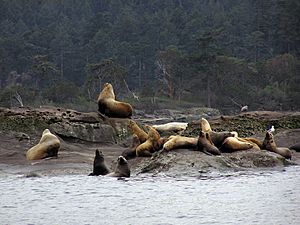
Steller sea lions live from the Kuril Islands in Russia to the Gulf of Alaska. Their range extends south to Año Nuevo Island off central California. In the past, they used to breed as far south as the Channel Islands, but they haven't been seen there since the 1980s.
Scientists divide the global Steller sea lion population into different groups. There's an eastern group and a western group, separated by a line through the middle of the Gulf of Alaska. Recent studies suggest there might be a third Asian group in the Sea of Okhotsk and Kuril Islands.
In the summer, Steller sea lions often move a bit further south. Even though they don't breed in Japan, many sea lions are seen around Hokkaidō in winter and spring. Sometimes, they are even spotted in the Yellow Sea, Bohai Gulf, and along the coasts of Korea and China. The oldest known fossil of a Steller sea lion was found in Japan. It dates back about 800,000 years.
Steller Sea Lion Ecology
Habitat and Home
Steller sea lions prefer to live in the cool, coastal waters of the subarctic region. Like all eared seals, they spend time both in the water and on land. They usually feed in the water. However, they come onto land to rest, shed their fur, and especially to reproduce and raise their pups.
These sea lions often gather on isolated islands. These islands are perfect because they help the sea lions avoid land predators. The islands also have cool winds, which help them stay at a good body temperature. Plus, it's easier for them to reach their food from these spots.
Some land sites are called rookeries and are used for breeding. Other sites are used for resting or molting. Many things can affect how much time Steller sea lions spend on land. These include how much food is available, how many predators are around, tide levels, and the weather.
What Steller Sea Lions Eat
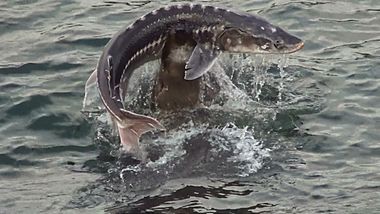
Steller sea lions are smart and opportunistic hunters in the ocean. They eat many different kinds of fish and cephalopods (like squid and octopus). Some of their favorite foods include walleye pollock, Atka mackerel, halibut, herring, capelin, flatfish, Pacific cod, rockfish, and salmon.
They seem to prefer fish that swim in schools. They mostly hunt in shallow areas near the coast and on continental shelves. They often gather in groups of up to twelve where there is a lot of food. Sometimes, they gather near fishing boats to eat fish that are thrown back into the water. Most of what we know about their eating habits comes from studies done in Alaska.
Their diet changes with the seasons and where they are located. Since they are opportunistic, they eat whatever prey is most common in their area. They sometimes go into estuaries (where rivers meet the sea) to eat fish that live in brackish (slightly salty) water, like sturgeon. Very rarely, they have been seen eating northern fur seals, harbor seals, and baby sea otters. It seems their diet has become more varied over time.
Who Hunts Steller Sea Lions
Steller sea lions are powerful hunters themselves, but they can also be hunted. Their main predator is the killer whale. Some types of sharks, like sleeper sharks and great white sharks, might also hunt young sea lions.
Steller Sea Lion Behavior and Life Cycle
Reproduction and Pups
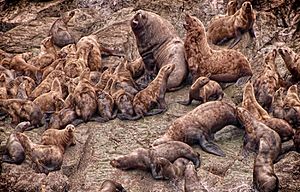
Male sea lions that are old enough to breed gather in mid-spring. They go to special breeding grounds called rookeries, usually on beaches of isolated islands. The bigger, older males claim and protect their own areas on the rookery. About a week later, adult females arrive, sometimes with their young from previous years. They form groups that move freely around the rookery.
Like all other eared seals, Steller sea lions have a polygynous mating system. This means one male mates with many females. However, the males don't force females into groups. Instead, they control areas, and females can move freely between them. Males who control areas that are partly in the water are often the most successful. These areas are marked by natural features like rocks.
Pregnant females give birth soon after they arrive at the rookery. Mating usually happens one to two weeks after giving birth. However, the fertilized egg does not attach to the mother's uterus until the fall. This means the egg can stay inside the female for up to three months before it starts to develop. Twins are very rare.
After about a week of nursing their pups on the rookery, mothers start taking longer and more frequent trips to find food. They leave their pups behind. Later in the summer, the mother and pup leave the rookery together. This is called the maternal attendance pattern. As pups get older, mothers spend more time hunting at sea. This continues until the pups are big and strong enough to find food on their own.
Male pups tend to drink more milk than female pups. This might be because males grow much larger than females. Breeding males do not eat during the breeding season. They often stay on land from mid-May until August. After that, the breeding groups break up, and most sea lions go back to the open ocean.
Pups can stay with their mothers for a long time, sometimes up to four years. It's very rare, but some mothers have been seen feeding their older daughters who are also feeding their own new pups. Studies show that how much time a mother spends with her pup depends on the pup's need for food. Females spend about 21 hours on land and 36 hours at sea. As pups get older, mothers spend more time at sea.
In the past, fewer pups were born, which was linked to mothers not getting enough food. This was thought to be a reason for the decline in Steller sea lion numbers in Alaska.
How Steller Sea Lions Move
Even though they are the largest eared seals, Steller sea lions are fast swimmers. They swim faster than the smaller California sea lions. They can glide through the water at about 2.9 to 3.4 meters (9.5 to 11 ft) per second.
Studies show that Steller sea lions get most of their swimming power from the forward push of their front flippers. They can change how long and how strongly they move their flippers to swim better. Steller sea lions are good at turning in the water, similar to other eared seals. They are better at it than whales and dolphins, but not as good as many fish.
Diving Abilities
To dive for a long time, Steller sea lions have special adaptations. They can hold their breath (apnea), slow their heart rate (bradycardia), and reduce blood flow to certain parts of their body (peripheral vasoconstriction). These adaptations help them save oxygen and hunt efficiently underwater. Their thick layer of blubber (fat) and outer fur also keep them warm during dives.
Scientists have studied trained Steller sea lions to learn about their diving. They found that diving uses more energy if the sea lions do many dives in a row. How well they can hold their breath during a dive also depends on how much food they have eaten.
Communication
Like most eared seals, Steller sea lions make sounds when they are on land. Adult male sea lions make different noises as part of their territorial behavior. These include belches, growls, snorts, and hisses, which warn other sea lions to stay away. Both males and females also make sounds underwater, like clicks, barks, and belches. These sounds are mainly used for social communication.
Underwater, Steller sea lions make low-frequency pulses that sound like the male's "belching" noise heard on land. These underwater sounds have about 20 to 30 pulses per second.
Sounds are very important for mothers and pups. Mothers need to find their pups in crowded breeding areas when they return from hunting. Both the mother and pup use special calls, almost like names, to recognize each other among many other sea lions. Their sounds on land have been described as similar to sheep bleating or cattle bellowing.
Because male and female Steller sea lions are different sizes, their hearing is also different. Females have more sensitive hearing than males. This might help them hear the higher-pitched calls of their pups. The Steller sea lion's hearing range also suggests they can hear the underwater calls of killer whales, one of their main predators.
Steller Sea Lions and Humans
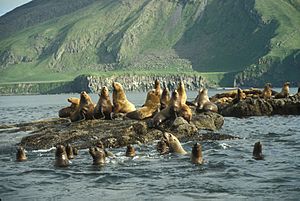
In the past, people living near Steller sea lions hunted them for meat and other things. Besides food and clothing, their skin was used to cover boats like baidarkas and kayaks. Today, some native communities in Alaska still hunt a small number of sea lions (300 or less) for their own use.
Historically, Steller sea lions did not have much commercial value. For example, in the 1800s, their whiskers were sold for a penny each to be used as tobacco-pipe cleaners.
Sometimes, fishermen intentionally kill Steller sea lions. They see the sea lions as competition for fish. Killing sea lions is against the law in the US and Russia. However, in Japan, a certain number are still removed each year, supposedly to protect fish stocks. In Canada, commercial hunting is banned, but special permits are sometimes given if sea lions are causing problems, like destroying fish farms.
In recent years, Steller sea lions have been seen entering the Columbia River estuary. They feed on white sturgeon, several types of salmon, and rainbow trout. Some of these fish species are protected by law in the U.S. Sea lions are found in the Columbia River almost all year, going as far upstream as Bonneville Dam. Even though they are not as common as California sea lions, they are still a concern for those who manage fish populations.
Since Steller sea lions are protected under the Marine Mammal Protection Act, managers must use non-deadly ways to scare them away. These methods include rubber bullets and noisemakers. It is strictly forbidden for the public to try to scare them away.
Recent Decline and Recovery
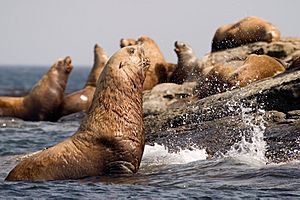
While the populations of the eastern and Asian groups seem stable, the western group of Steller sea lions, especially around the Aleutian Islands, dropped by 70–80% since the 1970s. Because of this, in 1997, the western group was listed as endangered in the United States. The eastern group was listed as threatened. Since then, they have been studied a lot and have been the subject of much debate in Alaska.
One possible reason for their sharp decline was too much fishing of Alaska pollock, herring, and other fish in the Gulf of Alaska. This idea is called the "junk-food hypothesis." It suggests that their diet changed from fatty fish like herring to leaner fish like pollock. This made it harder for them to get and store enough fat.
Other ideas for the decline include more hunting by orcas and sharks. Changes in climate might have affected the types of fish available. Diseases, pollution, and being shot by fishermen are also considered. It is likely that the decline is due to many connected factors that scientists are still trying to understand.
Another possible reason for the decline is the "Nutritional Stress Hypothesis." This means that a lack of food led to a decrease in the population. For females, not getting enough nutrients meant they couldn't complete their pregnancies.
However, in October 2013, the eastern Steller sea lion was removed from the U.S. Endangered Species List. This happened after their population made a big comeback over several years.
See also
In Spanish: León marino de Steller para niños



